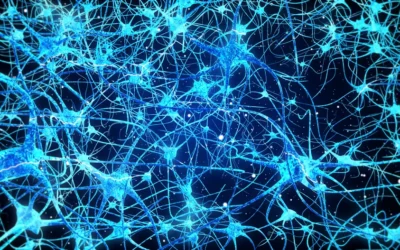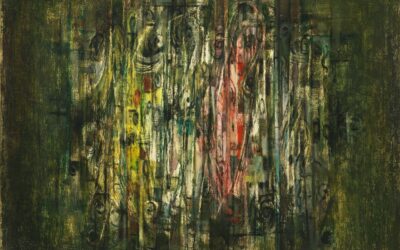When Light Meets Neuroscience
In the ever-evolving landscape of mental health treatment, breakthrough moments often come from the most unexpected places. What if the key to unlocking trauma, dissolving anxiety, and alleviating chronic pain wasn’t found in talking through problems or even in traditional brain-based therapies, but in the precise application of colored light wavelengths? This isn’t science fiction or new-age mysticism—it’s the cutting-edge reality of Emotional Transformation Therapy (ETT), a scientifically-grounded approach that’s transforming how we understand and treat emotional distress.
In a recent episode of the Taproot Therapy Collective Podcast, host Joel Blackstock sat down with MJ Denis, a Licensed Professional Counselor (LPC) and Licensed Marriage and Family Therapist (LMFT) from Austin, Texas, who has become one of the leading trainers in this revolutionary therapy. With over 3,100 ETT sessions under her belt and a journey that took her from complete skepticism to passionate advocacy, MJ’s story offers a compelling window into what may be the future of trauma treatment.
The Journey from Doubt to Discovery
Breaking Through the Skepticism Barrier
MJ Denis’s path to becoming an ETT expert wasn’t straightforward. Like many seasoned therapists, she had invested years in traditional modalities. After becoming a counselor in 2012, she pursued extensive training in sex therapy through AASECT, specialized in betrayal trauma recovery, and became certified in treating out-of-control sexual behaviors. She understood the landscape of talk therapy intimately—and also recognized its limitations.
“Talk therapy is wonderful and it’s effective, but it only gets so far,” MJ reflects during the podcast. This realization led her to explore brain-based interventions, starting with EMDR (Eye Movement Desensitization and Reprocessing). While EMDR proved helpful for some clients, she noticed significant gaps in its effectiveness. Some clients would experience what she describes as being “on a train” of memories, jumping from one traumatic experience to another without resolution, creating a messy and sometimes destabilizing therapeutic process.
The first time MJ heard about ETT, her reaction was dismissive. When colleague Dr. Annie Monaco suggested she explore this therapy using “light and color,” MJ’s response was an emphatic “Nope.” Even witnessing Dr. Steven Vazquez, ETT’s developer, demonstrate the technique at a conference, she assumed it was staged. “I absolutely couldn’t believe that transformation could happen that quickly,” she admits.
The Moment Everything Changed
The turning point came through proximity and persistence. MJ’s colleague Rick Reynolds, whose office was adjacent to hers, had trained in ETT and began sharing remarkable results. “MJ, I have a client with depression and I did ETT and the depression is gone,” he would say. Her initial response? A patronizing pat on the shoulder and “Sure, Rick.”
But the stories kept coming—anxiety resolved, OCD symptoms vanishing, ADHD presentations improving. Finally, when both their 8 a.m. clients canceled on the same day, Rick offered MJ an ETT session. What happened next challenged everything she thought she knew about therapy.
As Rick guided her through the process using colored sticks (part of the Multi-Dimensional Eye Movement tool), MJ experienced her emotions shifting in real-time. When she sat in front of the ETT spectral chart—a poster with strips of colors—something extraordinary occurred. The colors began to change before her eyes: expanding, disappearing, and returning as Rick helped her navigate through dissociation. In just 23 minutes, the intense distress she’d been carrying about a situation with her son had neutralized.
“When I thought about what was happening with my son, I mean neutral. My distress was reduced. My body, my nervous system felt calm,” she recalls. “Even though I had no idea what had just happened, I knew I had to get trained in this because he was on to something.”
Understanding ETT: The Science Behind the Transformation
The Neurological Foundation
Emotional Transformation Therapy isn’t based on wishful thinking or placebo effects—it’s grounded in solid neuroscience. As Joel Blackstock explains in the podcast, the key lies in understanding how our visual system interfaces with our emotional brain. “The optic nerve doesn’t go directly to occipital. It wraps around the brain stem and you feel 90% of what you’re seeing before you actually see it,” he notes.
This anatomical reality means that specific wavelengths of light can directly influence our emotional states before conscious processing even occurs. Dr. Steven Vazquez, the developer of ETT, didn’t stumble upon this accidentally. As Joel explains, Vazquez approached the development scientifically, building multiple devices based on neurological research. Of the six to eight devices he created, four proved effective and became the core modules of ETT.
The Four Pillars of ETT
The therapy utilizes four main tools, each serving a specific therapeutic purpose:
- The Spectral Chart: A precisely designed poster featuring strips of colors that can reveal and treat various emotional states. Patients often report colors disappearing, expanding, or changing—visual phenomena that correspond to specific neurological and emotional processes.
- Multi-Dimensional Eye Movement (MDEM) Wands: Colored sticks that therapists move in specific patterns while clients track them with their eyes, similar to but more targeted than traditional EMDR.
- Light Goggles: Specialized devices that deliver light at different angles to the eyes, capable of addressing both emotional distress and physical pain. Joel’s personal experience with a ruptured eardrum during training demonstrated their effectiveness—pain that was a “five-alarm fire” at one angle completely disappeared at another.
- The Light Device: A sophisticated tool that projects specific colors and flicker rates, sometimes producing visual phenomena where clients see images or symbols that relate to their processing.
How ETT Differs from Traditional Approaches
Unlike Cognitive Behavioral Therapy (CBT) or even EMDR, ETT works by directly engaging the subcortical brain—the emotional and survival-oriented parts of our nervous system that operate below conscious awareness. MJ explains the process as a “trifecta”: clients verbalize their issue, connect with their emotions, and receive visual stimulation through specific wavelengths of light that match their emotional content.
This approach offers several advantages over traditional therapies:
- Immediate results: Changes often occur within a single session, sometimes in minutes
- Replicability: The effects are consistent and predictable based on neurological principles
- Safety: Therapists can maintain better control over the process compared to EMDR’s sometimes chaotic memory chains
- Integration: ETT enhances rather than replaces other modalities
Real-World Applications and Case Studies
The Therapist Who Conquered Darkness
One of the most striking cases MJ shares involved a therapist in Portland who had been afraid of the dark her entire life. During a training demonstration, using the sentence starter “When I think about the dark,” the woman connected with intense fear. As MJ guided her through different colored lights—dark red for shock and loss, yellow for fear and overwhelm—something remarkable happened.
The woman’s brain spontaneously recalled being four years old during an earthquake, remembering the terror of being grabbed by her mother and fleeing their apartment building in darkness. She had no conscious memory of this connection before the session. Within minutes, her lifelong fear had dissolved. “I feel joy. I’m kind of excited it’s going to get dark tonight,” the therapist reported, astonished at her own transformation.
From EMDR Expert to ETT Convert
Perhaps one of the most powerful endorsements comes from an unnamed senior EMDR practitioner and trainer in Austin who had been using EMDR since the late 1980s. After experiencing ETT training with MJ and Dr. Vazquez, she worked through grief about not discovering ETT earlier in her career. The resolution was profound—she recognized how her EMDR skills could integrate with ETT, and remarkably, she no longer uses standalone EMDR in her practice.
Personal Healing at 30,000 Feet
MJ’s own accidental self-treatment on a Southwest flight demonstrates ETT’s accessibility. Suffering from a sinus infection and ear pain during air travel, she noticed the indigo airplane seats affected her differently depending on the angle she viewed them. By consciously working with these visual angles—essentially self-administering ETT—she managed her pain and anxiety, landing in Austin without the expected distress.
The Color-Emotion Connection: Decoding the Spectrum
Understanding the Emotional Spectrum
Through extensive practice, ETT practitioners develop an intuitive understanding of how colors correspond to emotional states and neurological processes. Joel Blackstock shares his evolved understanding after a year of practice:
- Orange: Represents self and ego, our center of identity. When orange “bleeds” into red, it indicates confusion between emotional needs and survival conditions.
- Green: Associated with action and expansiveness, sometimes manifesting as anger. Often appears as chest sensations or “black hole” feelings in attachment disorders.
- Yellow: Signals feeling trapped, controlled, paranoid, or constrained.
- Yellow-Green: The confusion between needing to act but not knowing what action to take—a space between anger and being boxed in.
- Blue / Blue-Green: Often emerges when someone needs to verbalize something previously unexpressed.
- Indigo: Can relate to anxiety and worry patterns.
- Red / Far Red: Connected to shock, loss, and primitive survival responses.
These associations aren’t arbitrary—they reflect consistent neurological responses across thousands of sessions. The beauty of ETT lies in how these patterns reveal themselves naturally during treatment, without the therapist needing to interpret or analyze.
The Dissociation Phenomenon
One of the most intriguing aspects of ETT is how it reveals dissociation in real-time. When clients dissociate while looking at the spectral chart, the colors literally change—expanding, disappearing, or distorting. This provides therapists with immediate, visual feedback about their client’s neurological state, allowing for precise interventions to bring them back “online.”
Integration with Other Modalities
Building Bridges, Not Walls
ETT doesn’t require therapists to abandon their existing training. Instead, it enhances and amplifies other approaches. MJ mentions Wayne Baker, an expert Internal Family Systems (IFS) therapist who successfully integrates ETT with parts work. The modalities blend seamlessly because ETT provides the neurological reset that allows deeper therapeutic work to take hold.
Somatic Experiencing, Brainspotting, and even traditional CBT can all be enhanced with ETT. As Joel notes, the best therapeutic models share certain characteristics:
- They provide immediate, replicable results
- They offer a universal language about emotion
- They empower both practitioner and client
- They scale with the provider’s expertise
ETT excels in all these areas, making it an ideal complement to existing practices rather than a replacement.
The Virtual Revolution
The COVID-19 pandemic accelerated many changes in mental health delivery, and ETT adapted remarkably well. MJ explains how therapists can now conduct sessions remotely using a specialized website where clients log in to access the light device through their phones, tablets, or computers. Even simpler interventions can be done over the phone using color apps, maintaining the therapy’s effectiveness while expanding accessibility.
This virtual capability addresses one of mental health care’s biggest challenges: geographic barriers to treatment. However, licensing restrictions remain a challenge, as therapists are typically limited to practicing within their licensed states. The ETT community is actively working to expand access while maintaining professional standards.
The Practitioner’s Perspective: Growth and Mastery
The Learning Curve
One of ETT’s strengths is its accessibility to therapists at all experience levels. MJ started using the techniques the Monday after her weekend training, and even new therapists can achieve meaningful results immediately. Yet the modality also offers endless depth for those who wish to master it.
The training progression includes seven levels:
- Levels 1-2: Learning the four basic tools and techniques
- Level 3: Protocols for trauma, depression, ADHD, OCD, and dissociation
- Level 4: Addressing physical conditions and chronic pain
- Level 5: Spiritual and existential issues
- Levels 6-7: Addiction treatment and couples therapy
From Technical to Intuitive
Joel describes the evolution from mechanical application to intuitive mastery. Initially, practitioners follow specific protocols—which colors to use for which conditions, how to recognize different response patterns. Over time, this becomes second nature. “You kind of have to start to feel how these things work,” he explains. “You have to watch, you have to get comfortable with like, okay, green’s in the chest, but when that pops, maybe it’s going to hop up into blue or blue-green.”
This progression from technical competence to intuitive flow mirrors the development path in many therapeutic modalities, but ETT’s visual feedback system accelerates the learning process.
Addressing the Skeptics: Evidence and Experience
The “Prove It to Me” Moment
Both MJ and Joel acknowledge the skepticism ETT faces. Joel’s approach is pragmatic: “I won’t talk to people about the science until they sit down. I’m like, ‘Look, if you’re going to sit on a couch for five minutes, I can show you something that you can’t explain.'”
This experiential approach proves more convincing than any amount of theoretical explanation. Joel himself spent weeks trying to “break” the system, attempting to make it not work as predicted. “I’m trying everything that I can to try and suggest something else to try and get it to not work like it’s supposed to because I’m doubtful,” he admits. Yet the neurological responses remained consistent and replicable.
Beyond Placebo
The specificity of ETT’s effects argues strongly against placebo explanations. Different colors produce predictable, distinct responses. The angle of light entering the eyes creates measurable changes in pain perception. Visual phenomena like colors disappearing or expanding occur without suggestion or expectation. These aren’t the hallmarks of placebo effects—they’re indicators of genuine neurological processes.
Moreover, the therapy works with skeptics. Both MJ and Joel entered their first sessions doubting, even mocking the approach. Their transformative experiences weren’t preceded by belief or expectation, yet the results were undeniable.
The Bigger Picture: Transforming Mental Health Care
Meeting the Moment
We’re living in a mental health crisis. Traditional therapy, while valuable, often requires months or years to achieve significant change. Medications help many but come with side effects and don’t address underlying trauma. EMDR and other trauma therapies have advanced the field but still leave gaps in treatment.
ETT arrives at a crucial moment, offering:
- Rapid relief for acute distress
- Long-term resolution of chronic issues
- Accessibility through virtual platforms
- Integration with existing therapeutic approaches
- A scientific foundation that satisfies skeptics
The Expansion Vision
MJ’s goal is ambitious but achievable: ETT-trained therapists in all 50 states. The therapy is already spreading internationally, with practitioners in France, Portugal, and Israel. Dr. Vazquez has trained therapists in 20 countries. This isn’t just about spreading a technique—it’s about fundamentally shifting how we understand and treat emotional distress.
The research base continues to grow, with practitioners documenting outcomes and refining protocols. As more therapists experience ETT’s effectiveness firsthand, adoption accelerates. The pattern MJ describes is consistent: skepticism, experience, conversion, advocacy.
Practical Implications for Different Audiences
For Mental Health Professionals
If you’re a therapist feeling stuck with certain clients or conditions, ETT offers a powerful addition to your toolkit. The training is intensive but immediately applicable. As MJ notes, you can start using basic techniques the day after Level 1 training. The investment in learning ETT often pays for itself quickly through improved client outcomes and retention.
Key considerations:
- ETT doesn’t require abandoning your theoretical orientation
- The techniques integrate seamlessly with existing modalities
- Training is available throughout the country
- Virtual capabilities expand your practice reach
- The community is supportive and collaborative
For Potential Clients
If you’ve tried traditional therapy, EMDR, or medication without complete relief, ETT might offer the breakthrough you’ve been seeking. The therapist directory can help you find certified practitioners in your area or those offering virtual sessions.
What to expect:
- Rapid changes, often within the first session
- A collaborative process where you maintain control
- Integration with any current therapy you’re receiving
- Relief for both emotional and physical symptoms
- A scientifically-grounded approach
For the Curious
Even if you’re not seeking therapy or providing it, ETT offers fascinating insights into consciousness, perception, and healing. The phenomena it reveals—colors disappearing, emotions shifting with light angles, memories surfacing through visual stimulation—challenge our understanding of how minds and bodies interconnect.
The Science of Rapid Change
Neuroplasticity in Action
ETT demonstrates neuroplasticity—the brain’s ability to reorganize and form new neural connections—in real-time. Traditional therapy often works through conscious processing and gradual reconditioning. ETT bypasses conscious resistance by directly engaging subcortical structures through the visual system.
This direct route explains the therapy’s speed. When the nervous system receives precisely calibrated visual input that matches its emotional state, change happens at the speed of neural transmission rather than the slower pace of cognitive processing.
The Body-Mind Bridge
ETT validates what somatic therapists have long known: the body holds emotional memory. But it goes further by providing a reliable method to access and resolve these body-held patterns. The consistent correspondence between colors, emotions, and body sensations across thousands of clients suggests universal neurological patterns that ETT effectively addresses.
Looking Forward: The Future of ETT
Technological Integration
As virtual reality and augmented reality technologies advance, ETT could potentially be delivered through new platforms. Imagine VR headsets calibrated to deliver precise wavelengths and angles of light, or AR applications that overlay therapeutic colors onto real-world environments. The core principles of ETT position it well for technological enhancement while maintaining its essential human-guided element.
Research Frontiers
While clinical evidence for ETT continues accumulating, formal research studies are needed to satisfy academic and insurance requirements. Areas ripe for investigation include:
- Neuroimaging studies showing brain changes during ETT
- Comparative effectiveness trials with EMDR and other trauma therapies
- Long-term follow-up studies on treatment durability
- Mechanisms of action at the cellular and molecular level
- Applications for specific populations (children, elderly, various cultural groups)
Accessibility and Training
The current requirement that ETT practitioners hold mental health licenses, while ensuring quality and safety, limits accessibility. Future developments might include:
- Specialized ETT technician roles under licensed supervision
- Self-help applications for specific conditions
- Integration into primary care settings
- Training programs in graduate counseling programs
- Insurance coverage as evidence accumulates
Light as Medicine
The conversation between Joel Blackstock and MJ Denis reveals more than just another therapeutic technique—it unveils a fundamental shift in how we understand emotional healing. ETT suggests that our visual system isn’t just for seeing the world but for regulating our internal emotional landscape. Light isn’t just illumination—it’s medicine.
MJ’s journey from skeptic to expert trainer mirrors the path many professionals and clients travel when encountering ETT. Initial disbelief gives way to curiosity, experience leads to conviction, and conviction transforms into advocacy. With over 3,100 sessions demonstrating consistent results, MJ’s confidence isn’t faith-based—it’s evidence-based.
Perhaps most importantly, ETT offers hope to those who’ve found limited relief through conventional approaches. In a world where mental health challenges are escalating, where traditional therapy waitlists stretch months, where medication side effects often rival the original symptoms, ETT provides a rapid, effective, and scientifically-grounded alternative.
The question isn’t whether ETT works—thousands of sessions have demonstrated its effectiveness. The question is how quickly it can be disseminated to those who need it most. As MJ says, “People consistently leave my office feeling better than when they got there.” In the end, isn’t that what all therapy should achieve?
For those ready to explore this revolutionary approach, whether as practitioners or clients, the resources are available. Training programs run regularly across the country. The therapist directory continues expanding. Virtual sessions make ETT accessible regardless of location. The light, quite literally, is spreading.
As we stand at the intersection of ancient wisdom about light and color with cutting-edge neuroscience, ETT represents more than a therapeutic technique—it’s a bridge between what we’ve always intuited about healing and what science now confirms. The colors that disappeared before MJ’s eyes that first day weren’t just optical illusions—they were windows into the profound capacity for rapid transformation that exists within us all.
The conversation ends, but the implications ripple outward. Every therapist who trains in ETT, every client who experiences its benefits, every skeptic who becomes a believer adds to a growing movement that’s redefining what healing can look like. In a world often shrouded in emotional darkness, ETT offers a different path—one illuminated by the precise application of light, grounded in science, and proven through experience.
The revolution isn’t coming. It’s here, one wavelength at a time.
For more information:














0 Comments